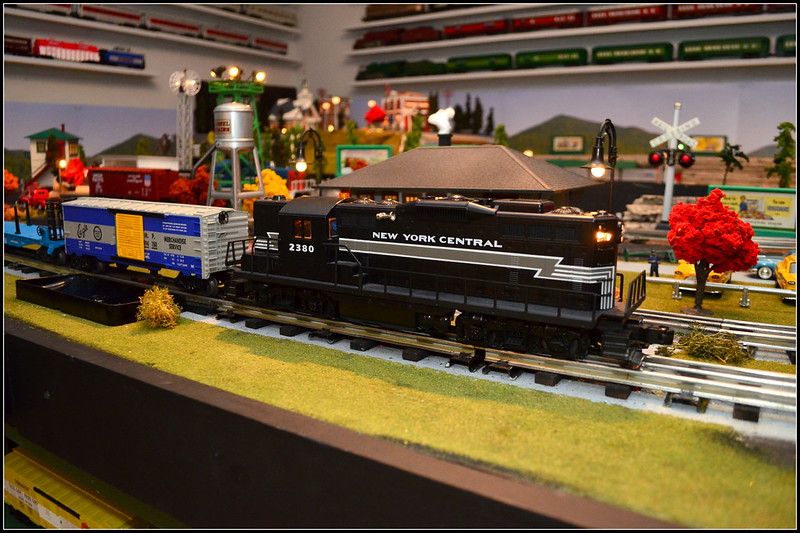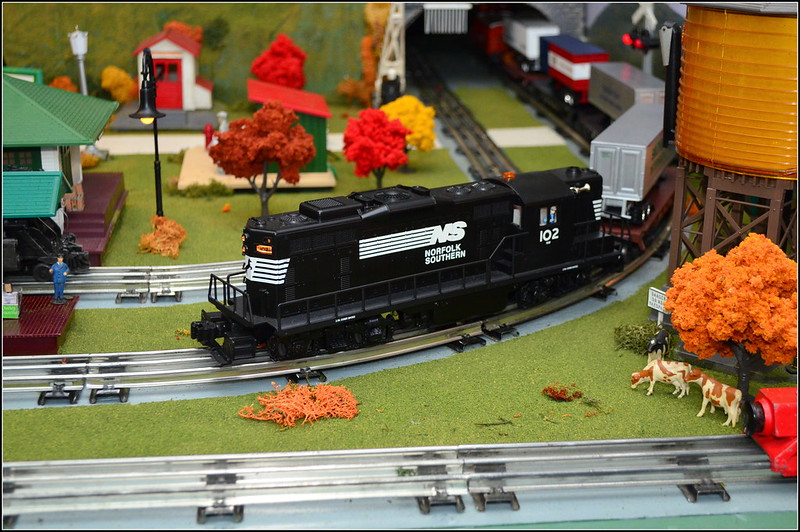Originally Posted by William 1:
I own over thrty pullmor equipped TMCC Geeps. They all pull twenty cars no problem. Better yet, get two, they are more fun to run together and combined they will pull down a wall of your house.
Well, let me launch into a long post here.  I'm a big fan of the GP-9s from the late 90s into the early 2000s, and later, that were equipped with TMCC and RailSounds. They can be run conventionally as well, but I'd suggest you look into a basic TMCC control system - not too expensive, and you'd enjoy it. The first of these, a NYC Lightning Stripe, was introduced in 1996. They're fairly inexpensive and bulletproof. They're scale-sized, of course, and when running along on a layout, it's hard to tell them from more detailed "scale" versions. Geeps were pretty unadorned engines to begin with. I've also swapped shells with some earlier MPC versions to give additional road names, which is fun and quite easy to do.
I'm a big fan of the GP-9s from the late 90s into the early 2000s, and later, that were equipped with TMCC and RailSounds. They can be run conventionally as well, but I'd suggest you look into a basic TMCC control system - not too expensive, and you'd enjoy it. The first of these, a NYC Lightning Stripe, was introduced in 1996. They're fairly inexpensive and bulletproof. They're scale-sized, of course, and when running along on a layout, it's hard to tell them from more detailed "scale" versions. Geeps were pretty unadorned engines to begin with. I've also swapped shells with some earlier MPC versions to give additional road names, which is fun and quite easy to do.
Besides TMCC and RailSounds (and incidentally the RailSounds on these Geeps is particularly good), the engines are equipped with electrocouplers, directional lighting, constant voltage lighting, and Magnetraction. The Pullmor motors on these engines are of a higher quality than many of those made in the MPC era.
Throughout the later 90s Lionel gradually added features to these engines as they were produced, adding electrocouplers, then diecast metal fuel tanks, then diecast pilots, cab interiors with crew figures, and so on. These later ones with all the diecast parts have a good heft to them and especially good pulling power.
One modification I make is to move the front headlight bulb (which is normally mounted above the cab) right to the front, directly behind the headlight lens. This greatly improves the brightness of the front headlight. (The rear bulb is already right next to the rear light lens, so that one is fine.) For variety, I made a modification to one engine when swapping a shell and putting with a TMCC/RS chassis with it, which was equipped with the roof strobe. Since the earlier shell didn't have the strobe, I drilled out an opening in the front below the headlight and added another lens, and mounted the flashing strobe bulb behind it to create a simulated MARS light.
In any case, these engines run very well. For example, I have a Milwaukee Road no. 18866 (from 1999, I think) which has cab no. 2383 (different from the year earlier model no. 18565 with cab no. 2338). The 18866 added diecast pilots, which the 18565 didn't have. Lionel also had refreshed the mold, so body details are a bit crisper on the 18866. I have this engine pulling the matching "B" unit, and it makes a nice looking set. The motor has been adequately broken in (a positive thing with Pullmor motors) and runs extremely smoothly and quietly, and at very low speeds.
The later versions should be of similar quality. Interestingly, Lionel also made 3 or 4 of these later TMCC/RailSounds GP-9s (Chinese production) which have dual DC can motors. I have one of these, and plan to add ERR cruise control to it.






